Top>Hakumon CHUO [Special Issue for Autumn 2009]>Roots of Chuo University (Part Two)
 Index
Index
Roots of Chuo University (Part Two)
What is the origin of the name Chuo University?
Where was Hakumon?
How did Straightforward & Steadfast become the school ethos?
General Lecture Course at the Faculty of Law: Chuo University and Modern Japan
A discussion with Professor Morikuni Sugawara, Professor Shuhei Honma, and Associate Professor Hideshige Arisawa
Correspondence Division where many young people coming to Tokyo studied was started in conjunction with the establishment of the university.
-- What kind of people were the students who studied at Igirisu Horitsu Gakko (the English Law School) during its early days? Could anyone study at the university?
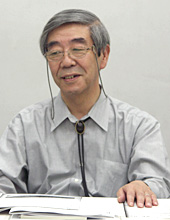
Professor Morikuni Sugawara
Honma:
Entrance requirements stated that applicants must be 18 years of age or older and pass an entrance examination. Although there is some uncertainty regarding the degree of difficulty, it is certain that an examination existed. The application for establishment of Igirisu Horitsu Gakko stated the academic standard for new students as graduates of elementary school or higher levels or education. There was no examination for what is currently referred to as auditing students, but this was not an official course.
Arisawa:
Around the early 1880s, there were increased movements demanding democratic rights. There was an overlap between the people conducting the movements for democratic rights and the people studying law. There were law students who participated in movements for democratic rights, and there were also people conducting movements for democratic rights who needed to study law.
In most cases, the social class level was former samurais known as the warrior class, people of a class level that had economic power. Next, outside of the warrior class, there were the sons of farmers who had gained a certain amount of independence and the sons of households that were peasants but held property.
Due to the situation at that time, young people possessed an urgent consciousness regarding the need to take some action, as well as a great ambition for learning. For these reasons, they were sensitive to a variety of matters. Therefore, many of them decided to study law.
-- What were classes like when Igirisu Horitsu Gakko opened (September 10th, 1885) in what was a household of the former shogunate?
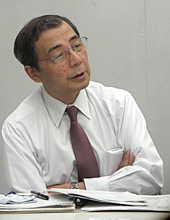
Professor Hideshige Arisawa
Arisawa:
Classes were in the late afternoon. They would start from 3 or 4 PM.
Sugawara:
Working individuals or young individuals employed at government offices would come to study from the late afternoon. Instructors would also come to Igirisu Horitsu Gakko to teach after finishing classes at other universities.
Although there is no longer a night school today, the night school was part of the tradition at Chuo University. Until just recently, it was a special characteristic of Chuo University that graduates of the night school were active in a wide range of roles in society.
Arisawa:
In a certain sense, it was education for employed adults.
Sugawara:
Really, at that time, there weren't many people who could afford to pay school fees. Many people sought to study even if they couldn't pay school fees. As a result, there was debate regarding what could be done for people without the opportunity to directly attend the instructor's lecture. This led to the start of the Correspondence Division (off-campus system) at the same time as the founding of our university. Simultaneously.
-- What do you mean by simultaneously?
Sugawara:
I mean that the Correspondence Division started simultaneously with the founding of Igirisu Horitsu Gakko in 1885. For the students of the Correspondence Division, a record of the lectures was distributed. The speech of the instructor was summarized, made in pamphlets and mailed to the students.
Correspondence Division leads to an increased number of students. Takuzo Hanai and Nyozekan Hasegawa were among the first graduating class.
-- Was Chuo University the first school to start the Correspondence Division?
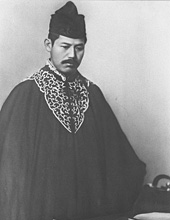
Takuzo Hanai
Sugawara:
Well, we were definitely a leader in the movement.
Honma:
In response to that question, some new research was recently released. Although it is said that Chuo and Hosei were the first to start authentic Correspondence Divisions, it seems that Meiji was already conducting such education 3 years earlier.
Sugawara:
But Chuo University was the first to make full utilization of such a system. Within 2 or 3 years, there were 20,000 applications for the Correspondence Division at our school.*1
Arisawa:
Young people from outside of the metropolitan area possessed an extreme ambition towards learning. They had marvelous energy. However, such young people didn't have the means to move to Tokyo. Therefore, they studied through the Correspondence Division.
Sugawara:
There were a lot of people who received a text in the mail, studied the material, and then did their best to achieve success in society. This energy and desire to succeed raised the Correspondence Division to new heights. As a result, the name of Igirisu Horitsu Gakko spread throughout the entire country.
Honma:
According to a report issued by Chuo University in 1887, there were 575 first year external students, 711 second year external students, and 441 3rd year external students.*2
-- What about the fact that there were only 4 students in the first graduating class of 1886?
Sugawara:
Those were students who transferred to our university from another school. Students who started from the first year and spent 3 years studying the full curriculum of Igirisu Horitsu Gakko were part of the third graduating class. Takuzo Hanai was part of that class. Takuzo Hanai ranked first among lawyers.*3
Honma:
He was the first Doctor of Law that was not a graduate of a government university.
Sugawara:
I have heard that it was even said that "there was no one like Hanai before Hanai, and there will be no one like Hanai after Hanai."
-- There were also the journalists Nyozekan Hasegawa and Sonjinkan Sugimura.
Sugawara:
Nyozekan Hasegawa, recipient of the Order of Culture award, enrolled in the Department of English law in 1893.
In 1889, name changed to Tokyo Hogakuin (Tokyo College of Law). Unable to realize a Tokyo College which unified law with medicine and literature.
-- In October of 1889, 4 years after the founding of Igirisu Horitsu Gakko, the school changed its name to the Tokyo Hogakuin (Tokyo College of Law). Why was the name changed?
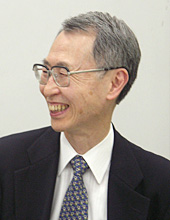
Professor Shuhei Honma
Honma:
Domestic law had not yet been developed at that time. Therefore, to state it rather bluntly, law schools were teaching English law and French law instead of domestic law. Then, in 1889, the Constitution of the Empire of Japan (Meiji Constitution) was issued. After that, laws such as the Civil Code (former Civil Code), Commerce Code (former Commerce Code), and Civil Procedure Code were promulgated in the following year.
Japanese laws were being developed at a rapid rate during this time. As a result, it was gradually becoming unreasonable to push Japanese laws aside and teach the laws of other countries. Therefore, there was a shift in orientation towards teaching the laws of Japan. So, I believe that the situation required the university to remove the label of English from the school name.
It is also said that the translation of Inns of Court was applied to the new school name.
Honma:
Another reason was the movement towards comprehensive universities. Tokyo Imperial University, which was established through a reorganization of the University of Tokyo in 1886, was used as a model for the formation of the Tokyo College Federation. The federation sought to create a private comprehensive university by merging the 3 universities of Igirisu Horitsu Gakko, the Tokyo College of Medicine and the Tokyo College of Literature. Although the plan did not succeed, it would have seemed strange for the names of the universities to be different when pursuing the change to a comprehensive university, and I believe that this was the reason for changing the name of our university to the Tokyo Hogakuin.
-- Why wasn't it possible to realize a private comprehensive university?
Arisawa:
To put it simply, the framework of the Tokyo College Federation fell apart, which was very unfortunate. My guess is that there was a lack of both money and participation.
Name changed to Tokyo Hogakuin Daigaku (Tokyo University of Law) and then to Chuo University (Chuo Daigaku). Divided into the 3 faculties of Law, Economics, and Commerce from 1909.
-- If the creation of a private comprehensive university had succeeded, it means that a Faculty of Medicine would have been established at Chuo University, right?
Honma:
I think the failure to realize such a university was a major blow.
Arisawa:
Both Meiji and Waseda have similar histories to Chuo University, and both of those universities didn't, or couldn't, establish a School of Medicine.
Sugawara:
However, Waseda then worked to enhance its science and engineering courses. Chuo University chose to continually persevere with a Faculty of Law in the arts and humanities. This continued until around 1903, when the name of the university was changed to Tokyo Hogakuin Daigaku (the Tokyo University of Law).
From around that time, there was a movement for enabling students to study economics as well. In 1905, a Faculty of Economics was established on the same day (August 18th) that the name of the university was changed to Chuo University. Furthermore, a Faculty of Commerce was established 4 years later on August 17th, 1909. This created a system with the 3 faculties of Law, Economics, and Commerce at Chuo University.
The Russo-Japanese War took place in 1904 and 1905. Therefore, by establishing a Faculty of Economics and a Faculty of Commerce, and by laying the framework of a university, an attempt was made to respond to movements in Japanese society that occurred around the Russo-Japanese War.
-- It is said that consideration was given to changing the school name to the "University of Tokyo."
Sugawara:
When the name of the school was changed to Tokyo Hogakuin Daigaku in 1903, the word university was simply inserted into the previous name of Tokyo Hogakuin. However, there was actually also a plan to change the name of the school to the University of Tokyo.
The name of the University of Tokyo was changed to Tokyo Imperial University and the name of University of Tokyo ceased to exist. Therefore, our school made a request to the Ministry of Education regarding a desire to change our name from Tokyo Hogakuin to the University of Tokyo. However, the ministry responded that such a name was not acceptable, and the decision was therefore made to insert the word university in the name of Tokyo Hogakuin.
Middle Temple is transformed into the name Chuo University!? The Hakumon (White Gate) makes its first appearance in the Chuo University Newspaper.
-- So, if the Ministry of Education had approved the change, the name of our university would be the University of Tokyo! When looking through documentation, there are various explanations as to why "Chuo University" was chosen for the school name.
Sugawara:
There really is no established theory. One explanation theorizes that the word Chuo was used because several founders of the university had studied law at Middle Temple in England (chuo is Japanese for middle). Another explanation states that the location of the university was in the middle of Kanda and the middle of Tokyo, and that this sort of consciousness may have been used to seek the meaning of the middle of scholarship.
Chuo University hasn't left much in the way of past documentation. Specifically, there are many unclear areas. It isn't clearly known when the school emblem was created or where the decision was made regarding our school colors.
-- Did such documentation burn in fires?*4
Sugawara:
Well, it certainly is true that fires may have been responsible for the loss of documentation.
Arisawa:
The fires were undoubtedly a major factor in the loss of documentation. Plus, although recording methods have been established and required items are saved today, such consideration for records wasn't given in the past.
-- How about the origin of Hakumon (White Gate)?
Sugawara:
Hakumon? Currently, it can actually be traced back to the Chuo University Newspaper, which was published by a newspaper society of an Association of Student Clubs. I believe that the founding of the newspaper was around 1927. In a subsequent issue of the newspaper, a column appeared which used the phrase Hakumon.
-- Around what time was that?
Sugawara:
It was about 1929. I didn't bring any of the materials today, however. Anyway, I believe that the name Hakumon. existed from before that time, and therefore a column for letters from readers was run in the newspaper.
Arisawa:
I don't think anyone officially decided on the name of Hakumon. As often happens, the name was probably naturally born among students as a kind of student vocabulary.
-- Did the gate called Hakumon (White Gate) actually exist?
Sugawara:
When I am asked if Hakumon actually existed, I have to say that, no, there was nothing.
However, after World War II, a white-colored gate was constructed. When Building No. 1 of the Ochanomizu Campus was built, the Main Gate which was built on Hijiribashi Street was called Hakumon. Also, there is the reconstructed pillar of a gate at the Centenary Stage within the forest on the right-hand side after passing through the Main Gate of what is now the Tama Campus of Chuo University. This pillar is from the former main gate and was called the South Gate after the war.
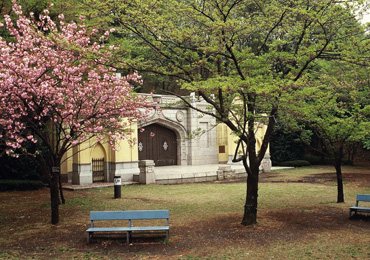
Centenary Stage (Sakura Plaza, Tama Campus)
A monument in the image of the South Gate (former Main Gate) of the former Surugadai Campus and a building (entrance of Building No. 2).
The phrase Straightforward & Steadfast, used in a speech by the President in 1914, became the school ethos as a reflection of the historical background during the war.
-- Reference is often made to Chuo University's school ethos of Straightforward & Steadfast. What are the roots of this ethos?
Sugawara:
The phrase Straightforward & Steadfast first appeared at Chuo University in 1914 when it was used in reference to a graduation ceremony speech given by the President of our university (President Yoshito Okuda). The editor of the Chuo Law Review, a publication of the Faculty of Law, ran that speech in the newspaper under the title of The School Ethos of 'Straightforward & Steadfast'.
-- Was the phrase Straightforward & Steadfast actually used within the speech?
Sugawara:
The speech discussed "developing solid individuals of high moral standards" and other topics related to the concept of Straightforward & Steadfast. However, the phrase was not included in the title of the speech. Straightforward & Steadfast became the school ethos of Chuo University because university officials attached the title of The School Ethos of Straightforward & Steadfast. Also, the phrase Straightforward & Steadfast was frequently used from the end of the Meiji Era to the beginning of the Taisho Period.
-- So, use of the phrase continued to spread from that time?
Sugawara:
I would like university officials to become aware of this fact, and to separate the school ethos from the founding philosophy of our school.
Arisawa:
Even now, entrance examination materials give an introduction of schools. The introductions are performed using an image looking from outside of the university. The university office did not decide on this school ethos or wish to make it the face of our university; rather, the image of Chuo was interpreted as such. Then, before anyone noticed, that image worked its way into a speech given by the President. That is one aspect of the situation.
Sugawara:
Another aspect is the influence of the Japanese government.
Arisawa:
The Japanese government during World War II made great efforts to emphasize the concept of Steadfast & Straightforward to the students of universities and technical schools. So, there was a general trend to use Steadfast & Straightforward as the ethos of many schools, not just at Chuo University.
Then, the slogan of Chuo University was decided upon by Raizaburo Hayashi. The phrase Steadfast & Straightforward was used in a speech given by President Raizaburo Hayashi in 1938.*5
-- So, President Raizaburo Hayashi decided on the slogan of Straightforward &Steadfast?
Sugawara:
The decision to make it our school ethos was made afterwards. As I stated earlier, before that time, it was a government policy to establish the ethos of Steadfast & Straightforward throughout Japan from the end of the Meiji Era to the Taisho Era.
Serious Chuo University students with a sound mind. Although poor, fierce ambition to study leads to Chuo University.
-- I am part of the education facility referred to as Honoh-no-Tou (Tower of light, Torch of learning). Students studying law at Honoh-no-Tou are truly and completely devoted to their studies. Personally, I imagine that the spirit involved in the study of law leads to the concept of Steadfast & Straightforward. What do you think about this idea?
Sugawara:
Straightforward implies the quality of seriousness. Steadfast refers to work performed with a sound mind. In that respect, I believe that the mindset which you describe is possessed by graduates of the Faculty of Law who are active in the legal profession, as well as by those who are active in society in some other aspect.
-- I also have the image of low-income students.
Sugawara:
The inexpensive school fees were appealing. In particular, students who entered Chuo University from before World War II until after the war chose our school because the school fees were less expensive than other universities. At that time, our school was known as Chuo, a pillar of legal scholarship in Japan. I believe that there were many students working part-time among the students who had a fierce ambition to study law.
In university counting rhymes (kazoe-uta), Chuo University students were always portrayed as looking for a discount. The reason that such lyrics appeared was that Chuo University students studied while dealing with poverty. That is, after moving to the Tama Campus. Nowadays, from the clothes students wear to the possessions of students, there is nothing about the appearance of Chuo University students that give the impression of poverty.
Arisawa:
Before the period of rapid economic growth in Japan, you could tell the affiliation of university students by their appearance.
Sugawara:
I have heard people conjecture that a student must be affiliated with Chuo University because they have a serious appearance!
-- I believe that Chuo University students have a serious image. I have heard it stated that, although Chuo students are serious, there are few students who are willing to stand at the forefront of a situation and exercise leadership.
Sugawara:
There may be many students whose thinking is to have someone else act as a leader and then to act as second or third in command. Perhaps it was necessary to emphasize the concept of Straightforward & Steadfast because there were students who held that kind of thinking.
The current Chuo University exists as a result of the 125 years that have passed since the school's founding. In the future, I hope that students will continually reflect upon that tradition and will create new history for our university.
-- Thank you very much for taking the time to participate in this interview.
*1: In the Journal of the Association for Legal Study that was published in September of 1888, it was written that "English Law School, the most recognized of the 5 major private law schools, is becoming progressively more active" and that "this year, English Law School shows a trend of even greater activity, with more than 20,000 applications currently received for external students."
*2: There were 97 day students (internal students) when Igirisu Horitsu Gakko opened. However, the success of the Correspondence Division (off-campus system) increased the reputation of the university, and the number of internal students had increased to 613 just 2 years later.
*3: The number of graduates rapidly increased as follows: 4 in the first class (1886), 18 in the second class (1887), 51 in the third class (1888), 143 in the fourth class (1889), and 208 in the fifth class (1890).
Members of the first graduating class included Takuzo Hanai, Raizaburo Hayashi, Shigema Oba, Shunosuke Inada, Nyozekan Hasegawa and Sonjinkan Sugimura.
*4: Both the school building and the Takahashi Legal Library were burned completely in the Great Kanda Fire of 1892. In 1917, a fire caused the complete destruction of the school building and library, and also damaged the Okuda Collection (including the Birkmeyer Collection). In 1923, the Great Kanto Earthquake resulted in the loss of all buildings, except the new school building and library.
*5: At an entrance ceremony speech given in April of 1938, Raizaburo Hayashi, the first Chuo University graduate to assume the position of Principal, raised the 3 concepts of Steadfast & Straightforward, Autonomous Beliefs, and a Warm and Supportive Atmosphere as the "Spirit of Chuo University."
[Interview/Composition]
Editorial Office and student reporters (Maria Nomura (3rd year student at the Faculty of Commerce), Kanako Ishikawa (2nd year student at the Faculty of Law), and Takito Hori (2nd year student at the Faculty of Letters).
- Research Activities as a Member of Research Fellowship for Young Scientists (DC1), Japan Society for the Promotion of Science (JSPS) Shuma Tsurumi
- Important Factors for Innovation in Payment Services Nobuhiko Sugiura
- Beyond the Concepts of Fellow Citizens and Foreigners— To Achieve SDGs Goal 10 “Reduce Inequality Within and Among Countries” Rika Lee
- Diary of Struggles in Cambodia Fumie Fukuoka
- How Can We Measure Learning Ability?
—Analysis of a Competency Self-Assessment Questionnaire— Yu Saito / Yoko Neha - The Making of the Movie Kirakira Megane








